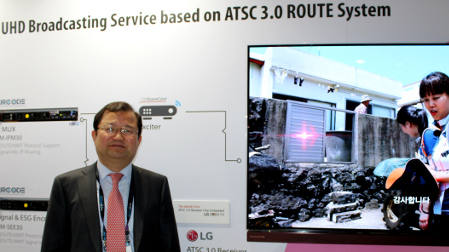Korea Reveals Its Plans for UHDTV at NAB Show
LAS VEGAS—In an exclusive interview at the NAB Show, Jae-You Choi, vice minister of Science, Information & Communications Technology and Future Planning for Korea, discussed the country’s plan to transition to UHD television broadcasting and also for providing 4K coverage of the 2018 Winter Olympic Games to be held in Pyeongchang. He disclosed that experimental broadcastsare already underway, and that regular UHD transmissions would begin early next year in Seoul and these will be expanded to other regions of the nation at a fairly rapid pace.

Vice Minister Jae-You Choi
“We are preparing to launch the world’s first terrestrial UHD service in February 2017,” said Choi, speaking through an interpreter. “We will start service in the Seoul metropolitan area and the surrounding areas and then expand that service into [cities near] the Olympic venues, and in 2021 we will launch a nationwide service. The plan is to provide coverage to 77 percent of the country by the end of 2017.”
ATSC 3.0 USED IN DEMOS, BUT NO OFFICIAL DECISION YET
Choi noted that UHD has been available in Korea since 2014 via cable, IPTV and satellite distribution services, and that, while no government decision has been made to adopt a particular transmission standard, ATSC 3.0 is currently being used for these demonstrations. (Korea launched its current DTV service in 2001 with the ATSC 1.0 transmission standard.)
Choi pointed to the demos that took place at the Korean Pavilion at the NAB Show that will show how UHD will look over ATSC 3.0. “In June this year, after reviewing all the overall circumstances in the domestic situation, we are going to decide the terrestrial broadcast standards for UHD television,” he said.
Asked about plans for getting the Korean public used to the idea of 4K TV service, Choi said that there is already a campaign in place to do this with announcements about the launch of ultra high-definition service being made by television broadcasters.
Get the TV Tech Newsletter
The professional video industry's #1 source for news, trends and product and tech information. Sign up below.
“In Korea there has been established a group or association of electronics makers and broadcasters called ‘DTV Korea,’ to launch a full-scale publicity campaign,” he said.
The Vice Minister added that he expected the government will set up a program to help existing HDTV owners transition from the ATSC 1.0 transmissions now used to the new broadcast standard via set-top boxes or similar devices.
“When we were transitioning to digital TV in 2012, the government provided set-top boxes for viewers who did not have digital receivers,” said Choi. “As for the UHD transition, while we haven’t set up any detailed plans yet, I believe there is the possibility of a similar situation. There may be a special law enacted to support the transition in this way.”
When asked about a cut-off date for conventional high-definition broadcasting, the Vice Minister said this will likely happen in 10 years or so, but a complete timeline is not in place yet.
“In December of 2015 the government set up the launch plan for UHD, but we haven’t gotten into the details of a termination for regular HD service,” said Choi. “We are going to set up measures to prevent any kind of discrimination against regular HD viewers. We are planning to end regular broadcasts in about 10 years, but no firm date has been established.”
MAJOR COMMITMENT TO KOREA’S UHD FUTURE
Choi observed that the move to UHD is being heavily supported both by the government and private broadcasters.
“As for the Korean government, our policy direction is that UHD is a very important part of our next-generation broadcast industry,” he said. “We believe that the most important part is to have quality content in UHD and we set up public-private partnership funding to support the creation of content and also to implement policies for UHD technology. We do not yet have any plans or mandates in place that would force broadcasters to create UHD content or air it, but we do have a kind of consultation body with various stakeholders to set policy for UHD, so we are talking about this. And from the Korean terrestrial broadcasters’ side, they have already made commitments to the Korean government that they will invest about (U.S.) $5.9 billion to create UHD content and improve facilities to make UHD programing available.”
READYING FOR THE OLYMPICS
When asked about the number of Korean homes that will be watching the Pyeongchang 2018 Winter Games in UHD, the Vice Minister stated that this should be significant, citing a report from a study group that predicted some 180 million UHDTV sets in homes globally by the end of 2018, with more than 10 percent of these in Korea.
“In Korea it is predicted that there will be 1.91 million UHDTV sets in homes; this is significantly higher than the global average,” he said.
Choi noted that in connection with the Winter Games 4K telecasts, the Korean government will suggest to the host broadcaster, OBS (Olympic Broadcasting System), to create UHD programs with popular events to be shown in real-time. A special “UHD Broadcasting Equipment Experience Studio” will also be open to allow broadcasters visiting from other countries to learn more about what is involved in getting ready for 4K broadcasting.
“I hope that you will have the chance to come to Korea and experience this,” said Choi.
See also:
TV Technology’s ATSC3 silo.
